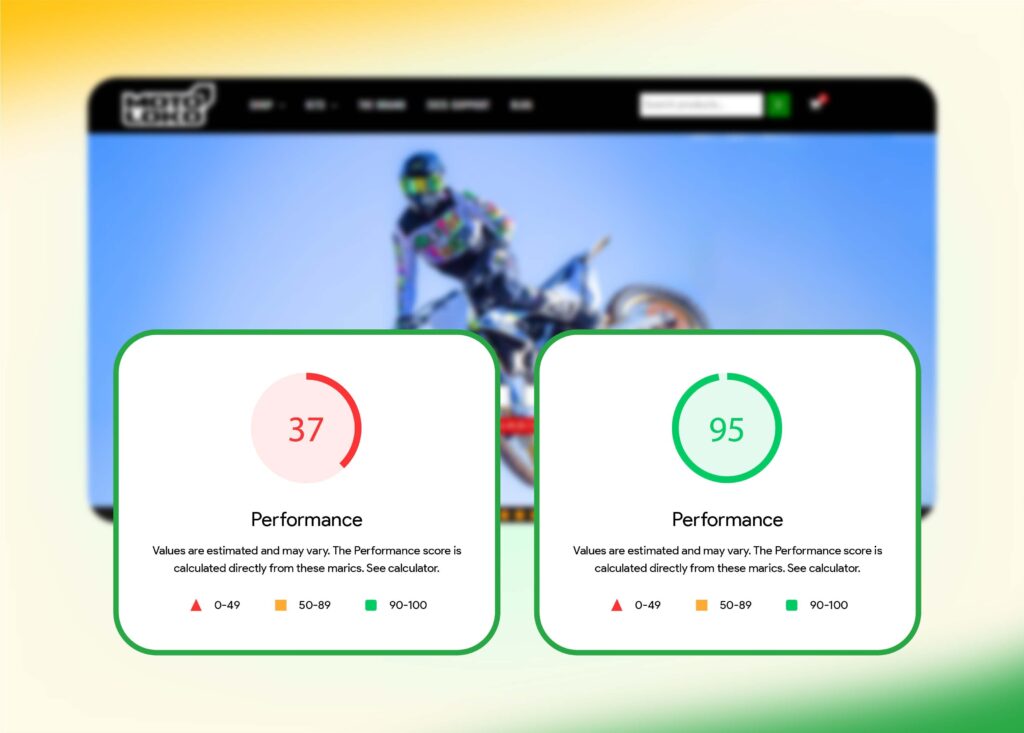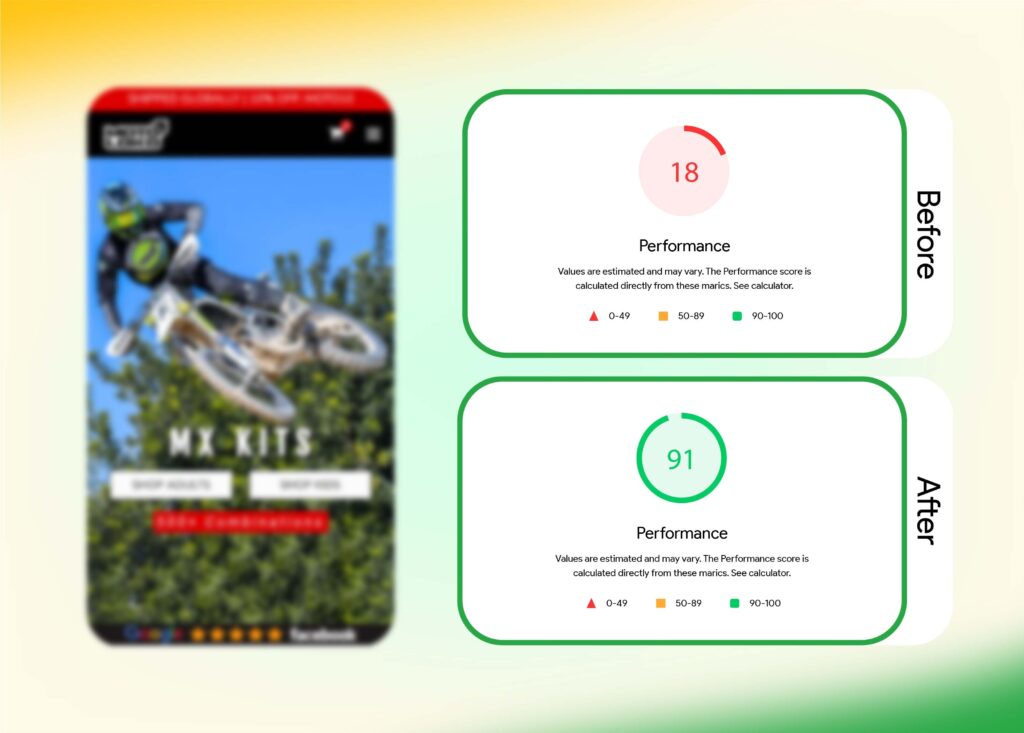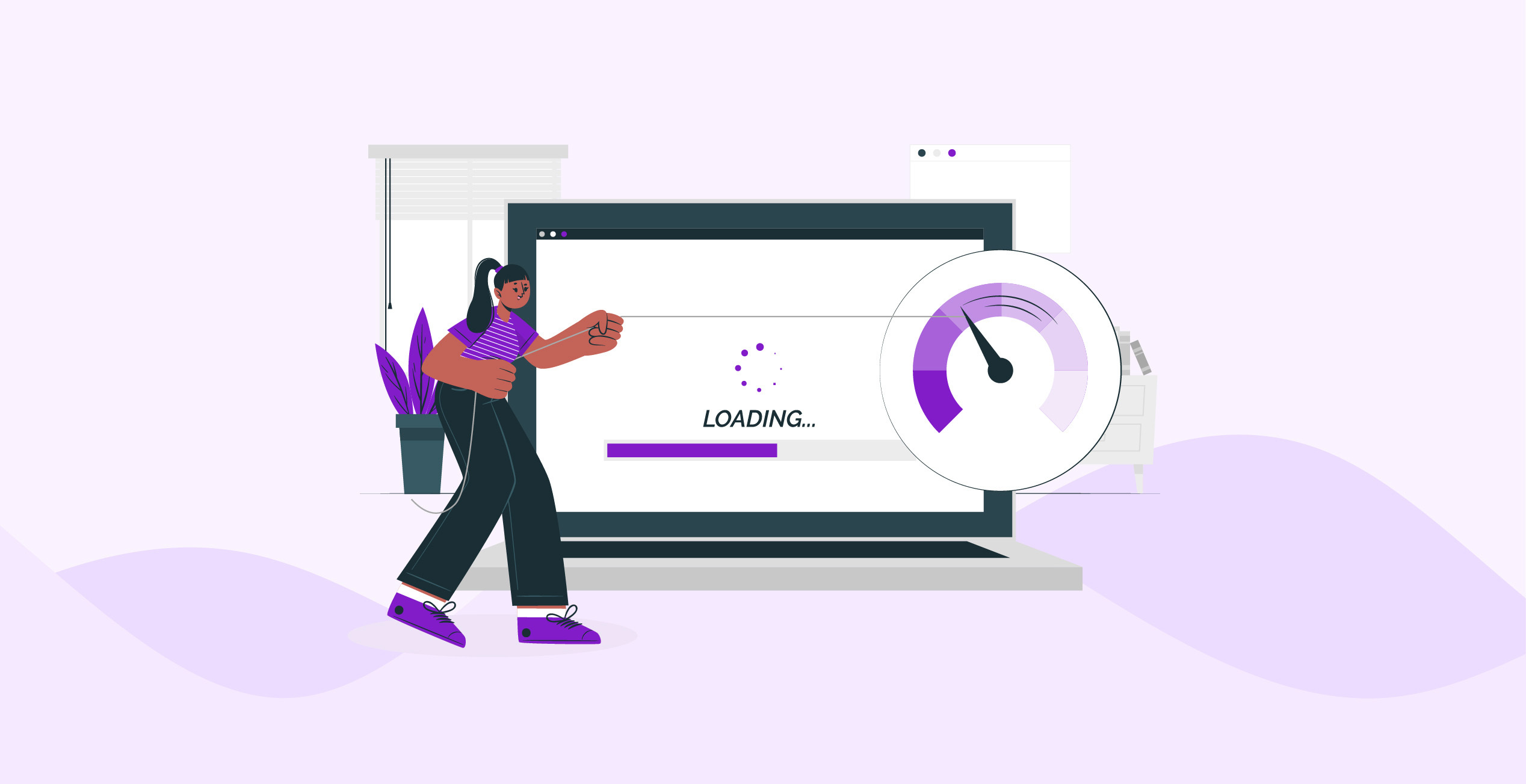Does your WooCommerce store feel like it’s stuck in molasses?
Most blogs will tell you the same old tune: use a caching plugin, shrink your images, maybe switch to a faster host. That’s fine if you are looking for incremental wins. But when you are running a revenue-driven eCommerce site, “fine” is not enough.
Google says each additional second of delay can decrease conversions by up to 20%, and 53% of mobile visitors abandon a page if a website takes more than 3 seconds to load.
We recently slashed the ecommerce website’s page load time by over 70%, turning a sluggish online store into a lightning-fast experience. This post breaks down exactly how we did it so you can do the same on your WordPress site, especially if performance is hurting your conversion rate.
Let’s get into the guts of it.
Here is What Happened:
We took an e-commerce business from a sluggish 5.3-second load time to under 2 seconds. And we didn’t do it with duct tape plugins or vague advice. We used real engineering, precision audits, and deep performance tuning.
- How we identified hidden bottlenecks
- What tools and stacks we used (and which we trashed)
- The exact workflow we followed to get 70%+ speed gains
- And how you can use this same blueprint to supercharge your own WordPress site
The Problem: Bloated WordPress + WooCommerce Stack
That ecommerce business runs a full-blown WooCommerce store with dynamic content, multiple product variations, and several third-party integrations (tracking pixels, upsells, custom checkout features, etc.). When we first audited the site, it was a classic performance sinkhole:
- Homepage Load Time: 5.3 seconds
- Product Pages: 6-7 seconds
- Largest Contentful Paint (LCP): above 4s
- Server TTFB (Time to First Byte): 800ms+
- Mobile Performance: borderline unusable on 4G
And the worst was that they were already using WP Rocket and an image optimization plugin. So clearly, plugins alone were not cutting it.

Our Process of Diagnosing and Fixing Performance Issues
When a site comes to us with a slow page speed problem, we don’t just guess the problem, slap a few plugins, and voila! We take a forensic approach that starts with a full site audit, because you can’t fix what you don’t measure. When we audit an eCommerce site, we are not just looking for red flags; we are pinpointing what’s actually slowing things down and costing you conversions.
We use tools like Google PageSpeed Insight, GTmetrix, and Pingdom to measure key performance indicators. Time to First Byte (TTFB) is an important KPI. It measures how fast your server starts delivering content. A slow TTFB means poor hosting or misconfigured caching.
Core Web Vitals are Google’s user-focused performance metrics, which greatly affect rankings and user experience. Google takes three critical aspects into account.
- Largest Contentful Paint (LCP): How long does your main content take to load?
- First Input Delay (FID): It measures how quickly your site responds when users interact.
- Cumulative Layout Shift (CLS): This quantifies the visual stability of the page by measuring unexpected shifts in page elements.
We also analyze the total page weight, image sizes, and how many requests are made to load a page. Similarly, JavaScript and CSS files that block the rendering of your content are a big performance killer. We identify them, defer or async load them, and clean out what’s not needed.
If your server is taking too long to respond, everything else suffers. Even the most aggressive frontend optimizations cannot deliver if the server is not good.
The Speed Optimization Tactics that Made the Biggest Impact

To boost the loading performance of an eCommerce site, you cannot rely on just one or a few elements. There are so many aspects to cater to achieve a blazing fast website. Here are the strategies that helped us achieve a 70% page speed improvement in the case of Moto-Loko.
1. Hosting & Infrastructure Upgrade
The hosting environment determines your TTFB, server uptime, and how your site handles spikes in traffic. A slow TTFB delays everything, including HTML rendering, asset loading, and user interaction. Website’s TTFB was hovering around 1.9 seconds, far above the ideal.
What we did:
- We migrated the website to a dedicated server environment, giving it access to server resources with an NVMe SSD storage.
- Our developers made performance-based tuning like configuring HTTP/3 and RLS 1.3 for faster HTTPS negotiation, optimal resource utilization, and faster processing.
- We also set up object caching and server-level GZIP compression to reduce the load on the database and server.
TTFB dropped to 180ms globally, and backend load time improved drastically. Moreover, the website became more stable and responsive during peak traffic hours, leading to a smoother experience for every visitor.
2. Media Optimization
Images are often the heaviest assets on eCommerce sites. This e-commerce website has an extensive and visually rich product catalog. But most images were large and unoptimized across product pages, galleries, and banners. Some were even over 6 MB. This forced the audience to download a major chunk before the page even began to render.
What we did:
Our team implemented a comprehensive media optimization strategy encompassing several key techniques.
- We employed lossless and lossy compression algorithms to carefully balance file size reduction with image quality.
- Images using outdated formats like PNG and JPEG were converted to modern formats like WebP and AVIF. The conversion often reduced file size by 30% to 50% without a noticeable loss in visual fidelity.
- We used the <picture> element and the srcset attribute in the tags to make images more responsive. This ensures that the browser downloads and displays the image appropriately based on screen size and resolution.
- Lazy Loading was also beneficial for speed optimization. The delay reduced the initial page load time and the data the browser needs to fetch upfront.
The comprehensive approach dropped the page weight by 60%, improved Largest Contentful Paint (LCP) from 3.7s to 1.9s on mobile, and significantly reduced the Bandwidth usage and hosting strain. Overall, the pages become visually complete and much faster, improving perceived performance and user engagement.
3. Database Cleanup
eCommerce databases can accumulate significant redundant, outdated, and fragmented data. This digital clutter can slow down the database queries, essential for retrieving product information, user data, and other dynamic content needed to render pages.
What we did:
A thorough cleanup process was required, which involved several steps.
- We analyzed database tables to identify and remove unnecessary entries. We eliminated old order tabs, deleted product information, temporary tabs, orphaned metadata, and post revisions.
- The process also includes optimizing table structures, indexes, and data types for efficient querying using various plugins and manual efforts.
- We fixed fragmentation to ensure data is stored on disk for faster access.
The database cleanup and optimization made the database lighter, resulting in faster server-side processing and contributing to lower TTFB and site responsiveness. Moreover, faster dynamic content loading also enhanced the browsing experience.
Important: Database is your website’s data center. Before doing anything to your database, always create a backup first.
4. Setting up a Content Delivery Network
Users across different regions experience different load times based on their distance from the server. It introduces latency issues for users geographically away from the server because data takes longer to travel. Moto-Loko has a major customer base in Europe, the United States, and Australia. Without a CDN, international shoppers suffered from slow speeds, especially on mobile.
What we did:
We integrated a leading Content Delivery Network into this e-commerce website. The geographically distributed network of proxy servers and data centers intelligently routes the request to the nearest server in its network. The reduction in the travel distance results in faster download times. The origin server is primarily responsible for serving dynamic content.
CDN implementation reduced the page load times in Australia and Europe by 50%, enhancing the user experience for international customers. Moreover, it also reduced the load on the origin server, improving its stability and ability to handle traffic spikes.
5. CSS and JS Optimization
Unoptimized CSS and JavaScript files can block the browser from rendering the page quickly. Large, unminified files require more time to download and parse, delaying the visual display of content and interactivity.
The website has dozens of render-blocking resources delaying page rendering. They were loading on every page, even when not needed.
What we did:
- Audited assets with Chrome DevTools and Coverage Reports
- Deferred or async-loaded non-critical JavaScript
- Stripped unused CSS and JavaScript, significantly reducing their file sizes without affecting their functionality.
- For large JavaScript bundles, we implemented code splitting to break them down into smaller, more manageable parts. The parts are then loaded when needed, improving initial page load time and time to interactivity.
Our efforts improved the First Input Delay (FID) to under 100ms, which was previously hovering at 300ms before optimization. Moreover, we were able to reduce the Total Blocking Time (TBT) by 75%, dramatically improving interactivity on mobile.
6. Theme and Builder Streamlining
Many website themes and page builders offer extensive customization options, but can introduce significant code bloat and unnecessary complexity. Moto-loko’s original site was built with a bulky drag-and-drop page builder. These tools inject unnecessary wrappers, classes, and scripts, hurting speed performance and SEO.
What we did:
- With a thorough analysis of the website’s page builder and theme, we identified areas for improvement and optimization.
- We rebuilt the homepage, product pages, and key categories using Astra.
- Many unused features, styles, and functionalities were eliminated because they were not used actively.
- Our developers analyzed the theme’s core code for inefficiencies and implemented optimizations with custom-coded sections for a clean and minimal backend where possible.
- We also reduced plugin dependency by hardcoding key features
Theme and builder streamlining contributed to improvements across multiple performance metrics, including FCP, LCP, and overall page load time. The site becomes lighter and more efficient, resulting in a snappier user experience. Moreover, SEO performance improved due to cleaner markup and faster page load times.
7. Advanced Caching Strategies
Caching allows browsers and servers to reuse previously loaded resources, reducing load times for repeat visitors. Caching strategies can help you reduce server resource consumption and delays. We implemented comprehensive caching strategies to store pre-built website versions at various levels.
What we did:
- Browser caching allows the website to store static assets like images, CSS, and JavaScript locally. The stored assets reduce page load times during subsequent visits to the same page or other pages.
- Caching the results of frequently executed database queries reduces the load on the database by serving cached results directly from memory. Object Caching speeds up the retrieval of dynamic content.
- We also utilized server-side caching mechanisms to store fully rendered HTML pages of frequently accessed data in memory. It allows the server to deliver cached versions directly to users without going through the entire process of generating them.
The caching strategies reduced the repeat page load time by 2x. Moreover, caching also improved TTFB and overall responsiveness, leading to a faster and more seamless browsing experience. Faster dynamic pages, like cart and checkout pages, faster loading, reduced cart abandonment rate, and improved reliability.
8. Managing Third-Party Assets
Third-party assets and plugins are essential for functionalities, but they can introduce performance bottlenecks. Each script adds delay and many load synchronously, blocking core content. This Ecommerce was filled with analytics trackers, chatbots, social media widgets, and review platforms. Each third-party script added overhead and blocked the rendering of critical page content.
What we did:
- The first step was to analyze the third-party assets loading on Moto-Loko and identify strategies to minimize their impact.
- We implemented asynchronous loading for non-critical scripts using the async attribute. It allows the browser to continue parsing the HTML and rendering the page while the script is being downloaded.
- For scripts that are not needed for initial rendering but are essential for functionality. We used the defer attribute to ensure they were executed after the HTML had been fully parsed.
- We also establish a process for regularly auditing third-party scripts to identify those causing performance issues or that are no longer necessary.
Effective management and removal of third-party assets led to improvements in various performance metrics, particularly FCP and time to interactive. The site felt faster and more responsive, even when the necessary external services were running in the background.
We Achieved The Website Speed That Converts
| Metric | Before | After | Improvement |
|---|---|---|---|
| Homepage Load Time | 5.3s | 1.6s | 69.8% ↓ |
| Product Page Load Time | 6.2s | 1.8s | 71% ↓ |
| TTFB | 800ms+ | 180ms | 77% ↓ |
| Mobile LCP | 4.1s | 1.7s | 58.5% ↓ |
| Page Size | 3.1MB | 1.4MB | 55% ↓ |
A measurable increase in conversion rate (we’ll leave exact numbers private, but it’s significant), and the bounce rate on mobile dropped like a rock.
Impact of Slow Loading Websites on User Experience and Conversions
The data paints a clear picture: speed is directly related to the success of your eCommerce business. A slow-loading website tests the patience of your visitors and affects your business’s bottom line.
- Lost Engagement: Slow-loading websites drive users away, which means lost engagement opportunities. Users who encounter sluggish loading times are more likely to abandon your site, resulting in reduced page views, less time spent on your website, and fewer interactions with your products.
- Impact Conversions and Revenue: The delays lead to cart abandonment, users hesitate to complete forms, and eventually lose interest in your offerings. As a result, you lose valuable leads and potential revenue opportunities.
- Decreased User Satisfaction: Your website reflects your brand. A slow-loading page gives the impression that you don’t value the customer’s time. This leads to a negative perception of your brand and decreased user satisfaction. Dissatisfied users are unlikely to return or recommend your business, whether you run an eCommerce store or a physical store.
- Lower Search Engine Ranking: Since July 2018, page speed has been a major ranking factor for Google. If user consistently encounter slow-loading pages from search engine results, it negatively impacts their overall search experience, and Google pushes your website lower in the search results. The downfall will lead to decreased organic traffic and missed opportunities to attract new customers.
This will give you a good idea of how slow loading speeds can negatively impact the user experience and conversion rate. They not only reduce sales but also make it harder for potential customers to find you.
Why eCommerce Sites Struggle with Page Speed?
eCommerce store owners often overlook the importance of speed. They build websites to look good, sell products, and deliver essential information. While it is crucial, it often comes at the cost of performance. Over time, heavy media, third-party tools, and plugins pile up, and suddenly your quick site starts crawling.
In our years of experience, we have found five common culprits behind slow load times.
- Wild Product Galleries: The beautiful zoomable images, showcasing every angle of a product, are fantastic for shoppers. But they can be mighty, and loading a bunch of them on a single page is like asking the browser to download a small library before the page even appears. We have even encountered carousels over 10MB in size.
- Oversized and Unoptimized Images: It’s not just galleries, product listings, banners, and general site imagery that slow things down if not properly optimized and served in modern formats like WebP and AVIF. Unoptimized images are the digital anchor that holds the entire page back.
- Heavy Page Builders and Themes: Drag-and-drop builders are incredibly easy to use but often generate bloated code with unnecessary layers and inline styling. Similarly, adding unnecessary features may seem good on the front, but the visitor’s computer has to do a lot of work behind the scenes, which increases the loading time. In many instances, simply streamlining the page structure built with a visual editor resulted in a 30% reduction in page size.
- Cheap or Shared Hosting: Speed starts at the server level. If you use a $5/month shared hosting plan, don’t expect lightning-fast load times, especially when you have an eCommerce store. It’s like running a marathon with a 20kg backpack. No matter how fast your website is, the server will slow it down.
- Army of External Services & Plugins: Chatbots, review platforms, live chat, affiliate tools, analytics plugins, each one adds an external script that your site needs to load. The plugins create a serious drag. Some tools even load before your content, meaning users have to wait longer before seeing something useful.
The Takeaway: Speed is Strategy
For an eCommerce store, website speed is the currency of customer satisfaction and conversion. This wasn’t a case of “tweak a plugin and cross fingers.” We built a system that delivers:
- Clean code
- Smart caching
- Minimal render-blocking
- Database-efficient WooCommerce
That’s how you get sub-2-second load times.
- We observed a significant decrease of 27% in the cart abandonment rate
- Similarly, the website bounce rate decreased by 39%
- Average session duration after speed optimization increased by 24%, and pageviews per session jumped by 15%. It suggests visitors were more inclined to browse products and spend more time on the website.
- The conversion rate experienced an 18% increase. This directly translates to more sales and increased revenue.
Want Results Like This for Your Website?
At TechUp Solutions, this is what we do: “engineering performance from the inside out.” If your WooCommerce store is slow, and you are tired of “quick fixes” that don’t last, let’s talk. We’ll show you how deep tuning can turn load time into growth.




